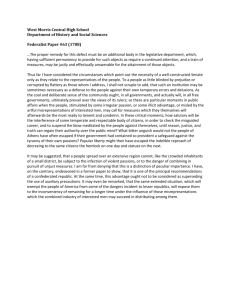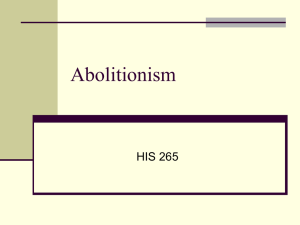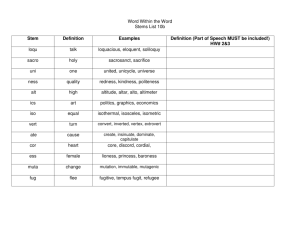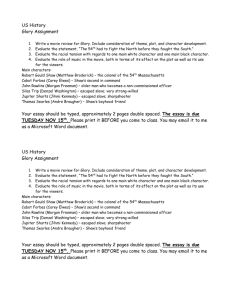Document 11236139
advertisement
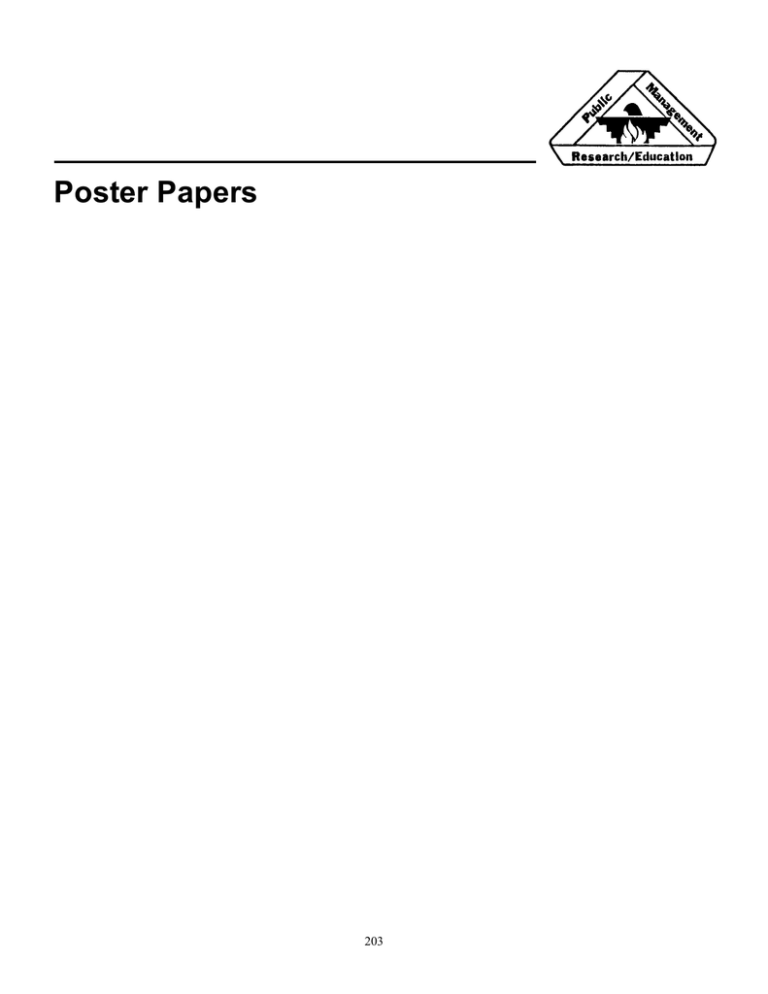
Poster Papers 203 Gen. Tech. Rep. PSW-101 Berkeley, CA. Pacific Southwest Forest and Range Experiment Station, Forest Service, U.S. Department of Agriculture; 1987. Evaluation of National Fire Management System's 1 Escaped Fire Situation Analysis A. P. Dimitrakopoulos2 According to National Fire Management Analysis System (NFMAS) assumptions, escaped fires are those that exceed the defined maximum size (1000 acres), containment time limit (8 hours), or the capabilities of the suppression forces dispatched by the user. Acreage for each fire identified as an escape is automatically assigned within the initial attack module from a user-established "escaped fire table" based on the annual frequency of each escaped event calculated by the program (USDA Forest Service 1983). The purpose of this table is to provide a consistent approximation of expected escaped fire size distributions for analysis purposes. It is based on the assumption that, for a given area, the historical size and annual frequency of escaped fires can be used reasonably to represent the average fire size over time for escaped fire events of a similar annual frequency in the analysis. Data from a 20-year period must be used as the basis for developing the "escaped fire table," to provide a sufficient distribution of historical fires to represent the probability of future escaped fires for the analysis. The escaped fires that occurred in the forest during the 20-year period are tabulated and grouped into fire size classes. Professional judgment is required to establish the fire size classes and determine whether a particular size class is appropriate for a given fire management analysis zone smooth distribution of average fire size classes and their related annual frequencies. The annual frequency of each fire size class is calculated by dividing the number of escaped fires that are grouped in each size class by the number of years that were used in the analysis. NFMAS procedures for estimating the final fire size of escaped fires rely heavily on the program user, because the user alone determines how many escape fire events will be included in each fire size class. The average size that will be assigned to each fire size class represents the arithmetic mean of the escaped fire sizes that are included in this size class, and consequently, depends on the number of fires that were grouped in this class according to the user's judgement. Care must be taken in assigning an average size at each escaped fire size class to ensure that the size predicted is consistent with the expected annual frequency of the event as evidenced by the historical records. In addition, the annual frequency that will be assigned to an average escaped fire size class depends upon the number of escaped fire events that are included in this size class. Thus, based on the historical annual frequencies of the escaped fire size classes and the annual frequency that was calculated by the program for a certain escaped fire event, a final fire size is assigned to the escaped fire. DISADVANTAGES OF USING NFMAS PROCEDURES FOR LARGE FIRES 1 Presented at the Symposium on Wildland Fire 2000, April 27-30, 1987, South Lake Tahoe, California. The NFMAS procedures for assigning acreage to fires that escape the initial attack capabilities and become large, have several disadvantages: 2 Department of Forestry and Resource Management University of California, Berkeley. 205 PROPOSED MODIFICATION OF NFMAS PROCEDURES FOR LARGE FIRES 1. Large fires are stochastic--not periodic--events with changing occurrence probabilities over time. Therefore, their annual frequencies and sizes can not be predicted from their historical distribution. Assigning large fire sizes according to their expected annual frequencies by intensity level will be a more consistent and realistic procedure for assigning a final size to escaped fires. The higher the fireline intensity of a fire, the higher the probability will be that the fire will escape and become large. As the fireline intensity increases, the rate of increase in fire size increases too, since the combustion rate and the rate of fire spread will be higher and, therefore, the suppression efforts more difficult. 2. NFMAS escaped fire size procedures rely heavily on the user. The user decides the number of of classes of average escaped fire sizes and the number of fire events in each size class that will be used to create the escape fire table. In this way, as explained above, the user determines the average size and the annual frequency that will be assigned to each escaped fire size class in the escaped fire table. Arbitrary decisions regarding the number of escaped fire size classes may lead to assigning annual frequencies to size classes that do not reflect the actual fire history of the area. Since the user is free to select as many size classes as are thought appropriate and no specific instructions are given in the NFMAS documentation, different users may come up with different sizes and annual occurrence frequencies of escaped fire events for the same forest, after conducting the initial attack analysis (IAA) fire behavior simulation. This will result in different suppression expenditures and fire losses for the same fire management zone, creating, confusion and uncertainty in decision making. For the fire behavior simulation procedure used in NFMAS to reflect reality, it is logical to expect most of the simulated escaped fire events to occur in the last three IAA fire intensity levels (4, 5, and 6). since they represent the most likely conditions that can result in an escaped fire. Procedure A procedure for assigning a final escaped fire size to fire intensity levels 4, 5, and 6 is given below: The sizes of escaped fires that occurred in the fire management analysis zone over a time period (not necessarily 20 years) are put in ascending order. The total number of escapes is divided by three, including the same number of escaped events in each of the three fire size classes that resulted from the division. Dividing the total number of escaped fires by three, determines the number of the escaped fire size classes that will be used in the escaped fire table, avoiding in this way any arbitrary selection and providing consistent methods regarding the number of escaped fire size classes that will be used in the analysis. 3. When the number of escaped fires that occurred in the forest over the 20-year period is small with a wide distribution of sizes, then the calculated annual occurrence frequencies of the escaped events are not realistic and reliable. 4. Drastic changes in fuels, fire suppression potential and practices, or fire management objectives in an area may change the fire environment to such an extent that the use of historical data for the prediction of large fire sizes and frequencies in the future, may be meaningless. Therefore, a modification of the NFMAS procedures for estimating the action of escaped fires is necessary in order to eliminate subjective judgments in the creation of the "escaped fire table," and to avoid nonrepresentative fire sizes and occurrence frequencies in a certain fire management analysis zone. Next, an average fire size is calculated for each size class by dividing the total number of acres burned in each size class by the number of fires that are grouped in this class. If, after grouping the fires in to three categories, the sizes of the fires in each are not more or less uniform, then extreme values can be excluded. Although this exclusion may be subjective, it ensures a smooth distribution of average fire sizes in the escaped size classes. 206 4. The annual fire frequencies are intermediate calculations in the NFMAS fire behavior simulation after the program run has been completed. These calculations create difficulties in the program calibration since the user does not know in advance the acreage that will be assigned to the escaped fires that occur at a certain fire intensity level. This may lead to unexpected results, since the user has absolutely no control on the acreages that will be assigned to an escape event from the escaped fire table. With the proposed modification the user will know from the beginning the fire size that will be assigned to an escaped fire at a certain intensity level and therefore will be able to better calibrate the model. Thus, additional program runs, time and money will be saved since it will not be necessary to modify the escaped fire table and rerun the program every time that unrealistic fire sizes occur. Finally, the escaped fire table is created by assigning the calculated average fire sizes to the last three fire intensity levels. Since the escaped fire sizes were grouped in ascending order the largest average fire size will be assigned to intensity level 6, while the smallest will be assigned to intensity level 4. Thus, a final size will be assigned to each escaped fire event according to the fire intensity level in which the fire occurred and not according to its calculated annual frequency. Advantages The proposed modification of the NFMAS procedures for escaped fire size has the following advantages: 1. The proposed modification is based on the fact that large fires demonstrate high fireline intensities. Since fireline intensity determines the suppression difficulties that are to be expected, higher intensities result in larger fire sizes. With the proposed procedure, large fires will be assigned to high fireline intensities, a concept which reflects reality. 5. Fires will not escape at low intensity levels (1, 2, 3) where fireline construction is adequate to hold the fire and handcrews are effective. Lower program levels, due to reduced suppression expenditures, will not result in escaped fires which occur in unrealistically low intensity levels. 2. In my modification, the escaped fires are not assigned according to their expected annual frequencies. The reason is that large fires are stochastic and not periodic events, have unpredictable occurrence probabilities and, therefore, their frequency cannot be predicted based on their historical occurrence. 6. The acres burned annually will depend on the number of escaped fire events and not on the calculated annual frequency of each escaped fire. The proposed modification of NFMAS procedures for assigning a final size to escaped fires will improve the model's inherent accuracy for the reasons mentioned. 3. The user's involvement in selecting the number of average fire size classes and, thus, in selecting the average fire size that will be assigned to each class, will be eliminated. Arbitrary classifications, which could lead to unrealistic annual frequencies for certain fire size classes in the escaped fire table will be avoided. Thus, unrealistic results due to escaped fire annual frequencies that are not representative of the fire sizes assigned to them on the escaped fire table, will not occur. REFERENCE U.S. Department of Agriculture, Forest Service. 1983. Fire Management Analysis and Planning Handbook 5109.19 207
